Artúr van Balen has produced inflatables for protest as a member of former group Eclectic Electric Collective and, now, Tools for Action. One such inflatable, a cobblestone for a 2012 demonstration in Barcelona, will be featured in ‘Disobedient Objects’. In this post we interview Artur about his own work, the role of inflatables, and their long history as objects of protest.

How did you get into making inflatables for protest?
In 2010, with the former artist group Eclectic Electric Collective, we created our first inflatable within a protest context. We had been at the demonstrations during the United Nations Climate Summit in Copenhagen in 2009 and we felt we should show solidarity with the protests at the UN Climate summit the following year in Cancún, Mexico. Not wanting to fly there to create even more emissions, it was a Mexican friend and painter who suggested we send an inflatable.
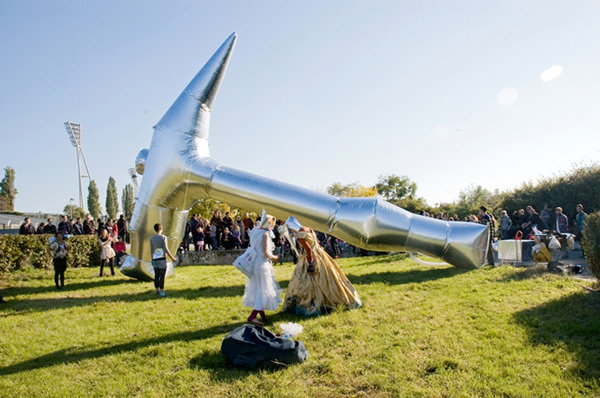
With my friend Jakub Simcik we organized a ten-day open workshop, where we called out to artists and activists to join us. Inspired by a quote ‘Art is not a mirror to society, but a hammer with which to shape it’, we collectively decided to make a hammer as an unconventional symbol for climate justice. We sewed a 12 meter silver inflatable hammer. It was then folded into a suitcase, and sent to a Mexican activist group protesting the ineffective policies of the United Nation Climate Conference in Cancún.

The news agencies broadcasted the hammer as the icon of the protest that day, showing footage of the group ´hammering´ the fences of the UN climate conference and how the Mexican police ripped the inflatable to pieces. That was the moment we understood how inflatables can create media spectacles. The inflation and deflation of the object itself can be seen as a metaphor for the temporary media spectacle itself.
You’ve made hammers, saws, oranges, cobblestones – even a pair of giant breathing lungs that inhaled and exhaled. How do you choose the objects you will make and where have these been used? Is it a collective process?
Except for the lungs it was always a collaborative process. It usually works like this: we are invited by an art- or activist group. Together with the group members we discuss what figure or object to make and then we run workshops on how to make them. We try to find symbols that resonate within the popular imagination and that contain multiple layers of meaning.
After the hammer, we have a tendency to think in terms of tools as everyone intuitively understands that tools are to be used. So when these giant inflatable tools are used for a protest or a blockade, they literally and symbolically visualize the collective leverage.
Thus far, this idea of tools can be seen in the 7-meter inflatable slipper we created with an Indian theatre group for a feminist demonstration in India. It was just one month after the Delhi gang rape in December 2012. To hit someone with a slipper counts as a big offence in Indian culture, so we collectively chose the slipper as a symbol to contest patriarchal thinking and authorities.
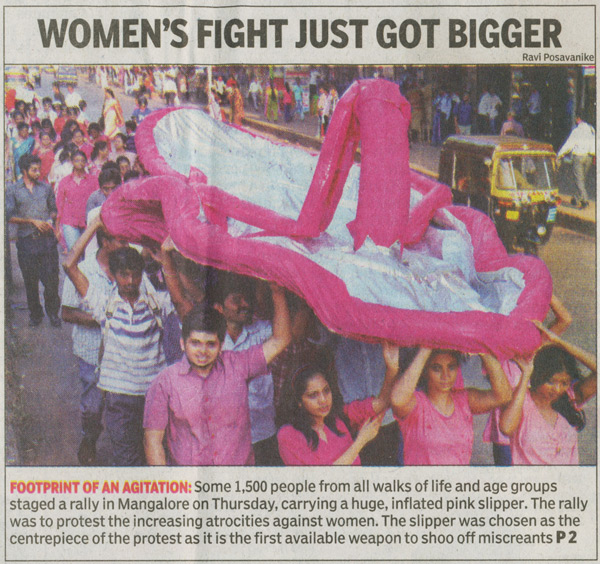
In Moscow we worked with the group Partizaning to create a 10-meter inflatable ‘saw’. In Russia the saw symbolizes corruption, as it divides the budget. The saw was used at an anti-Putin demonstration on the 6th of May 2013, after previous demonstrations in 2012 had been violently silenced by Russia’s government.
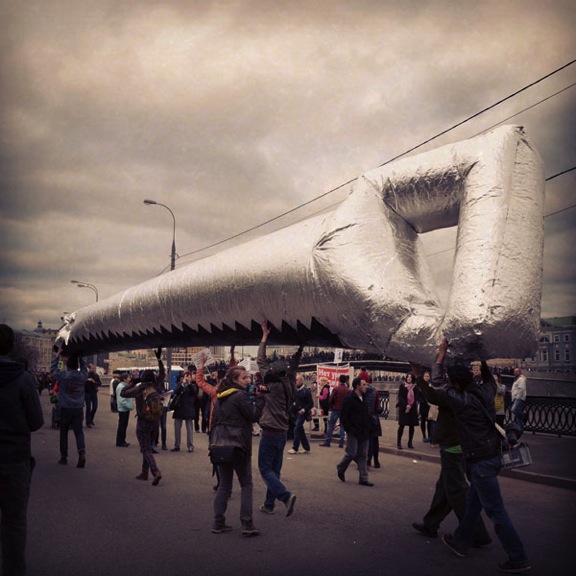
They’re often objects that become comical when they’re inflated in the street, or surreal objects – a hammer or stone made of air is a bit of a contradiction! What’s the meaning of such choices? They work as icons or props to frame an issue, but do they do more than this?
I personally like the contradictions. It also makes the work poetic and not so closed. You can associate more to it. To a greater extent, we also aim to use the inflatables – not as a prop in a march – but as a tool for intervention. The inflatable cobblestones are a good example of this. We call them a secret weapon of tactical frivolity: they transform a protest in a highly interactive and playful event, make it hard to control and all at the same time, they can physically protect people from a police baton.
It is especially interesting when you can create decision dilemmas with the objects and your opponent needs to decide what to do. In case of the cobblestones, the riot police at the May Day demonstration in Berlin decided to get rid of the inflatable by piercing it. They had problems with the slippery surface of the material and the scene this created was hilarious: everyone saw how a highly armed squad of riot cops tried to destroy a balloon. In Spain, protesters documented how two policemen arrested an inflatable and squeezed the bulky thing in a van.
David Graeber has written an essay for the book accompanying Disobedient Objects. He talks about how giant puppets can change the rules of a protest in public space, and make both the police and protestors act differently. Does this happen with inflatables too?
David Graeber’s essay of ‘On the phenomenology of Giant Puppets’ was a big inspiration to us as it illustrated how paper maché puppets can transform a protest into a carnivalesque situation. It is the same with inflatables, and it may even work better because inflatables are lighter and can bounce around in the crowd. I see paper maché puppets as a precursor of inflatables.
This is also true when you look at the history of figure balloons, as puppet makers were also the first inflatable makers.
Inflatables have a history in protests. In 1968 the UFO group in Italy blocked traffic with inflatables during demonstrations. Likewise, inflatables appeared in Soviet Parades in the 1930s. Do you consider Tools for Action as part of a history or a tendency? Do you look back at radical uses of inflatables before you for inspiration?
Until now our inspiration comes more from popular culture or stories within social movements. Inside movements, certain objects can gain extra importance, for example the penguin in the Gezi-Park protests after CNN Turkey showed a three-hour long documentary about penguins while the police violence against protesters in Taksim Square escalated. Another example is the egg thrown at former Ukrainian president Viktor Yanukovych during the run up to the unjust presidental elections back in 2004. His government officials claimed he was hit by a brick and rushed him to a hospital. Egging can be dangerous. However, this egg-incident seemed to have been a set up media event to deceive the public. It became a source for ridicule in Ukraine. I am fascinated when ordinary objects are suddenly loaded with symbolic meaning.
It is also important to look at what our predecessors have done. The Italian UFO group seems to be a pioneer. They were architecture students in Firenze and combined architecture with semiotic theory. Urboeffimiro nr. 5 I like the best! It is a rocket with the inscription “Colgate con Vietcong”, making the connection between the Vietnam War and American imperialism and consumer culture.
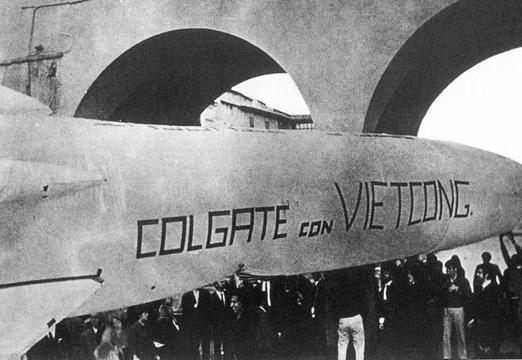
Personally I am most interested in the early history of inflatable figures. I was very surprised to find out that the Soviet Union used inflatables in their parades in the 1930s.
For example, the picture of the inflatable houses, made by the soviet photographer Georg Zelma, can be found on the internet. Until know I haven´t found more precise information what the event was about. Another picture of the same event shows an inflatable with a banner, saying: “Let´s exchange straw roofs for tiles!” Was it a parade of the Soviet fire brigade, a parade during the NEP to reform the housing structures?
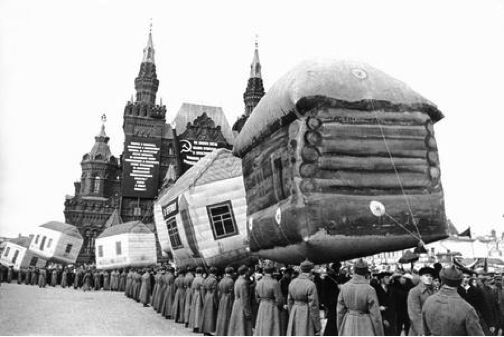
After personal archive research I found out other inflatable figures have been used in Moscow during Soviet celebrations. The inflatable figures had various themes from demonstrating technological progress with new high tech weather balloons, to their use as symbols of production carried by workers of a particular profession. They also created inflatables to ridicule political opponents. These comical inflatables of state enemies were a consciously planned “element of carnival”. The inflatable snake with the swastika on its head is a picture from the Red Square in 1934. It was mobilizing sentiments against the danger of national socialism in Germany.

In the same year, Walt Disney joined the Macy´s Thanksgiving Day Parade in New York with an inflatable mickey mouse. Since 1927 the department store Macy´s has held its famous annual parade with inflatable figures. Most of the objects were designed by the puppeteer Tony Sarg , who also designed the animated sculptures behind the shop windows. In this way the inflatable figures of the Macy´s Thanksgiving Day Parade can be seen as an extension of Macy’s shop window decorations. When you compare the inflatable figures from the United States with those in the Soviet Union, you can grasp the ideological function of these seemingly comical and fun objects. The figures in the Macy´s Thanks Giving Day Parade were not only figures for entertainment and advertising of the Macy´s store, they also became important in creating a collective feeling of national identity.
So if you look at the history of inflatable figures, you can see that inflatables were used from the very beginning as a tool for mass media communication (and manipulation). This leads to the question of how our inflatable practice differs from a commercial or authoritarian spectacle. I think the potential of d.i.y. inflatable making is that everyone can participate in the making of inflatable figures and can gain visibility in a protest. You can create images and stories that counter the ´dominant discourse´. For this reason, we also think of low-tech methods of inflatable making with double sided tape, so our technique is accessible and participatory for as many people as possible.
For example, you can see Tools for Action’s video tutorial on how to make an inflatable below.



Inflatable houses on Red Square, part of a “Kolkhoz” demonstration, Georgi Zelma, 1931. This is clearly a State organized celebration of collective farming, and the houses are presumaby intended to show that traditional village life has an important role in the Soviet State as long as the farming is done collectively.
Thank you for sharing such an interesting approach to art and an insight as to how it has been used. Like yourself, I am fascinated with how old this idea is, and how creative protestors had been with what materials they had. It is active art and purposeful/practical and beautiful. Bystanders are drawn to the occasion, whether they like it or not and that is again appealing. I look forward to viewing the exhibition.